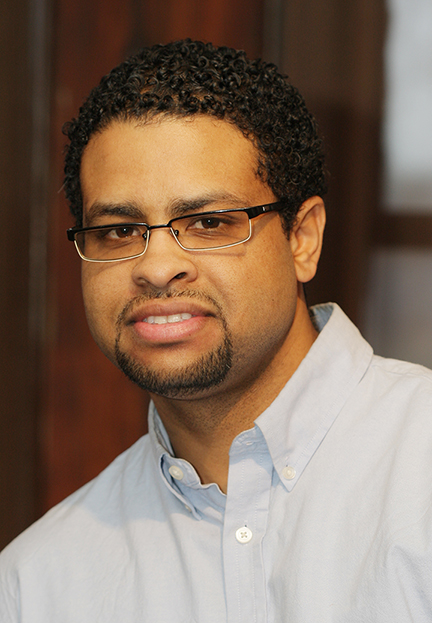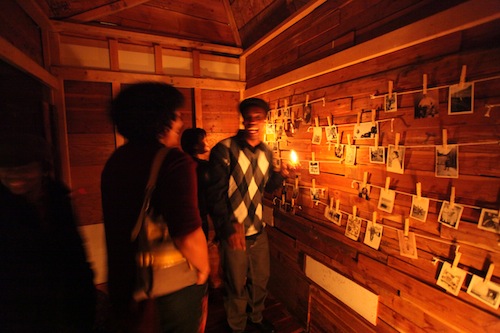Faheem Majeed is an artist, curator, teacher, and arts administrator. He likes to ask questions, challenge expectations, and mine sensitive subjects—whether he’s behind the desk serving as executive director of a “small black arts non-profit,” or in the studio welding a sculpture. By blending personal narrative with research-based facts, he metabolizes his influences and inspiration and makes them his own. He outlines some of his personal and professional history below, and illustrates how each informs his art work, which he leverages to catalyze conversation, activism, and community building.
There are a number of aspects of my personal history that shape who I am as a person and artist. My parents were both members of the Nation of Islam. Shortly after my birth they both denounced their affiliations and moved to Charlotte, NC. My father grew into a respected politician and businessman. I grew up in city where every other yard had a “Majeed Cares” campaign sign in it.
After an amicable divorce, I spent my teenage years with my mother in Minneapolis, MN. She was a respected social worker and executive director of a chemical abuse agency. She believed that no matter how dysfunctional they were, everyone needs a family.
This confluence of experiences and influences is the foundation of my work and really shaped my thoughts on the possibilities of the impact of my work. As I developed as an artist in Chicago, I combined that perspective with what I was learning about the black arts movement and groups like AfriCobra, Blacks Arts Guild, Chicago Imagist, Spiral, etc.
When I first came to Chicago in 2003, I didn’t know many people. Artists from the historic South Side Community Art Center (SSCAC) welcomed me into their space where I spent the next year absorbing and falling in love with its amazing history, constituency, and constant struggles. Rummaging through the SSCAC’s basement was more of an experiential education than I could obtain from the coursework and reading during my undergraduate studies at Howard University. The smell of aging paper, the accumulation of forgotten or abandoned art, uncovering posters and flyers from the ’40s and ’50s, and reading through the correspondence from past directors felt like coming home. Those objects spoke to me and each had its own story. The curator in me sees the ability to put these objects together in a way that is different from their originally intended purpose. I try to refocus the lens and tell a story that was not obvious or perhaps lacked a voice. I synthesize these objects into my work by discussing and sharing them with others and engaging and appropriating from the ones who created them.

Faheem Majeed. “Planting and Maintaining a Perennial Garden I,” Mixed Media, 2012. Courtesy the artist.
I was eventually asked to fill the position of executive director of the SSCAC. As I became more involved, my studio practice suffered. I was torn between two passions. I felt that I was at a crossroads and had to make a decision, so like any sane person that is faced with a difficult life decision, I decided to go to grad school.
I quickly figured out that, at the time, I wasn’t willing to step away from either role. So with that decision, my art practice shifted from welded steel figurative representations of my community to an administrative arts practice that creates institutional critiques of culturally specific institutions (you’ve got to love art speak). Basically, I use to be a steel sculptor and now I use my knowledge of running a small black arts non-profit space to challenge and draw attention to the strengths and needs of similar spaces.
In 2011, I stepped down as executive director and curator of the SSCAC. A year later, as a part of the South Side Hub of Production, I was asked to produce an intervention that engaged the building, so I decided to build a shack on the roof. I was driven by my realization that I was going through a transitional phase in my career. I was and still am a builder of institutions, organizations, and relationships but at that time, I was a man without an organization. I needed time to let go and move on so I asked myself: “Can I build without a clearly defined purpose or affiliation and be satisfied? And does it matter if it only satisfies me?”
The idea was to build a quaint yet visually engaging sculptural space with no defined content and see what happened. Well what happened was that people were attracted to the space and wanted to engage and build upon what was there. A handful of artists used the space for various interventions and while I knew some of them, there were others that were new to me. I was purposefully removed from the role of curator and gatekeeper from the project. I was excited about making a space with no curatorial voice. Just first come first serve. It was a great moment for me where I could recapture the concept of building, figuratively, and again create space that can speak to a community. The process helped me move forward and [this] summer, I am expanding the project with a much more intentional approach towards encouraging involvement across communities.
In terms of the aesthetic value, I’m highly concerned with the visual appeal of my pieces but I’m not creating to appeal to others visual preferences. The thought or idea inspires the medium and the medium drives the appearance of the final outcome. As an artist and curator, I always want to create a compelling aesthetic and I put my all into everything I create because I want the end product to be something of quality, something I’m proud of. But in terms of how others receive what I am making, I like to feel that they see what I put into it rather than just seeing a beautiful object. I want them to connect to its patina, use, and history so that it takes more than one glance to really answer the question of its aesthetic value. My work should grow on you.
I am very excited about my new role as administrator and faculty at University of Illinois at Chicago’s (UIC) College of Architecture and Arts. I feel like a big part of my being asked to come back to UIC is my past success of marrying my role as an administrator and artist into an engaging art practice. Many of the students coming out of our program are either interested or already very involved in civically engaged art practices.
As told to Thea Liberty Nichols via email in March 2013. Thea is Blogger-in-Residence through April 29, 2013.






Pingback: Group Walking Tour and Collaborative Sculpture | Faheem Majeed | date | time |
Pingback: Brother Faheem Majeed: His first solo museum exhibition | Notable Alphas